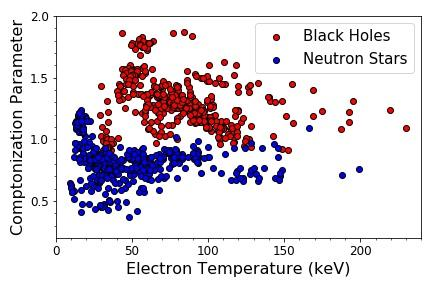Sep 22 2020
An international group of astrophysicists has discovered unique signatures of black hole event horizon, unquestionably differentiating them from neutron stars—objects, similar to black holes in terms of size and mass but confined inside a hard surface. This is undoubtedly the strongest steady signature of stellar-mass black holes to date.
 The graph shows measured values of two source properties—electron temperature and Comptonization parameter—from many X-ray observations of about two dozens of black holes and neutron stars. It is clearly seen that the black hole (red symbols) and the neutron star (blue symbols) are almost entirely separated in an unprecedented manner, thus identifying the black holes indubitably. Image Credit: Srimanta Banerjee, Sudip Bhattacharyya, and Marat Gilfanov.
The graph shows measured values of two source properties—electron temperature and Comptonization parameter—from many X-ray observations of about two dozens of black holes and neutron stars. It is clearly seen that the black hole (red symbols) and the neutron star (blue symbols) are almost entirely separated in an unprecedented manner, thus identifying the black holes indubitably. Image Credit: Srimanta Banerjee, Sudip Bhattacharyya, and Marat Gilfanov.
The group included Mr Srimanta Banerjee and Professor Sudip Bhattacharyya from the Tata Institute of Fundamental Research, India, and Professor Marat Gilfanov and Professor Rashid Sunyaev from Max Planck Institute for Astrophysics in Germany.
The Space Research Institute of Russian Academy of Sciences in Russia is publishing this study in an article that has been accepted for publication in the Monthly Notices of the Royal Astronomical Society.
As predicted by Einstein’s theory of General Relativity, a black hole is a mysterious cosmic object without a hard surface. While the black hole lacks a surface, it is restricted within an imperceptible boundary, known as an event horizon, from within which nothing can escape (including light). Conclusive proof of the reality of these objects is a holy grail of contemporary physics and astronomy.
So far, only one giant black hole—whose mass is over six billion times that of the Sun—has been imaged using the nearby radiation in radio wavelengths. However, stellar-mass black holes with masses of approximately 10 times the mass of the Sun, must bend the spacetime around them by a minimum of ten thousand trillion times more than a giant black hole does. Therefore, smaller black holes like these are essential to probe a few extreme features of nature.
Gravitational Waves
When these smaller black holes combine together, they could be deduced from gravitational waves. Such gravitational waves are temporary events, persisting only for a fraction of second and it is of huge interest to have a decisive proof of the existence of an unwavering stellar-mass black hole, which illuminate primarily in X-rays by consuming material from a companion star.
A neutron star is essentially the densest familiar object in the universe with a hard surface. In a similar way, the neutron star can also shine in X-rays by accumulating matter from a companion star, defined by very high efficiency of conversion of the rest-mass energy mc2 to radiation, of the order of 20%.
To establish the existence of stellar-mass black holes, it is important to differentiate them from such neutron stars. The study’s authors have achieved precisely that.
Using the archival X-ray information from the currently decommissioned astronomy satellite Rossi X-Ray Timing Explorer, the team has detected the effect of the absence of hard surface on the perceived X-ray emission, and thus have detected a highly robust signature of accreting stellar-mass black holes.